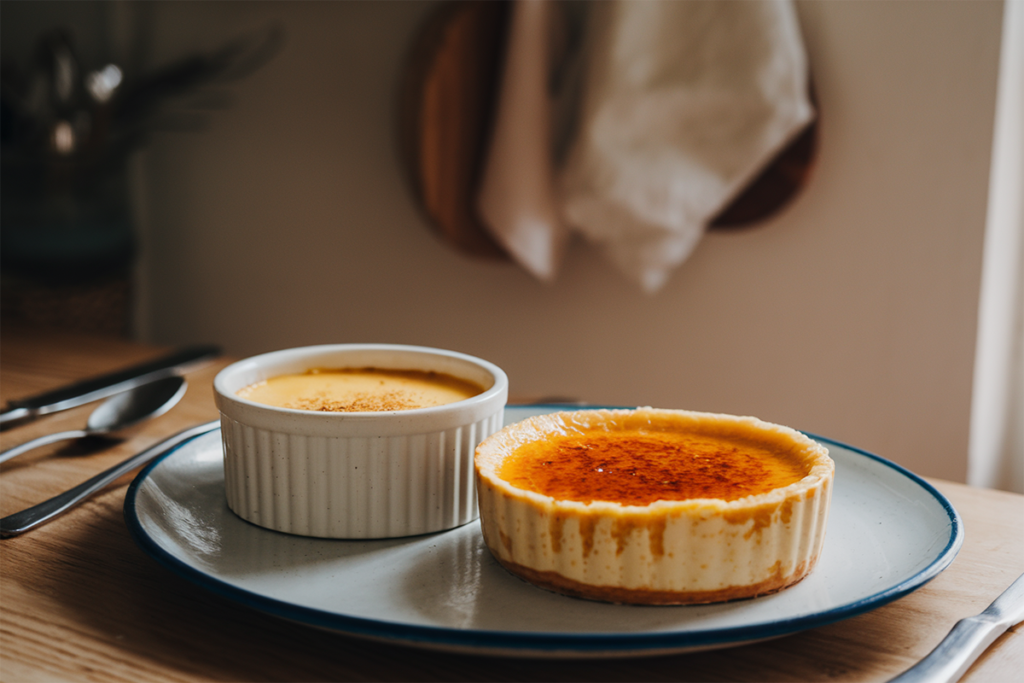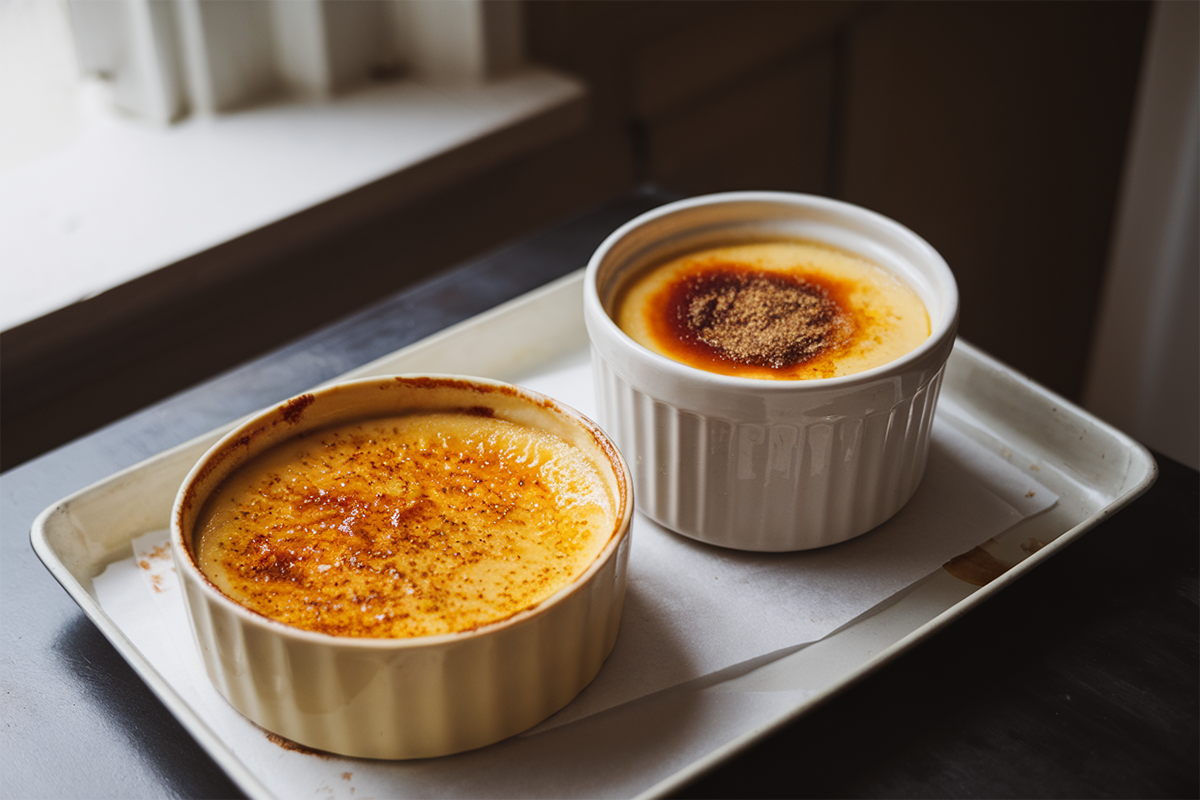Both high-end restaurants and cozy family dinners often feature baked custard and crème brûlée, two beloved desserts. While both are rich, creamy, and custard-based, they differ in many ways. These differences include their ingredients, preparation methods, texture, and flavor. In this article, we’ll explore the nuances that set baked custard and crème brûlée apart. We’ll delve into their origins, cooking techniques, and cultural significance, including how traditional recipes like Amish baked custard have influenced modern dessert making. By the end, you’ll have a clear understanding of these two desserts and how they compare to other custard-based treats, and why they continue to captivate dessert lovers around the world.
Table of Contents
Introduction to Custard vs Crème Brûlée
What are the differences between baked custard and crème brûlée?
Baked custard is a simple yet elegant dessert that combines eggs, sugar, and milk or cream, gently baked until it sets. The texture is smooth and creamy, and you can flavor it with vanilla, nutmeg, or other spices. People often serve baked custard plain or with a light caramel sauce, making it a comfort food favorite that families have enjoyed for generations.
On the other hand, crème brûlée is a French dessert that takes baked custard to another level by adding a caramelized sugar topping. This topping is created by sprinkling sugar over the set custard and then using a torch or broiler to melt and brown the sugar, forming a thin, crunchy layer. The contrast between the creamy custard and the brittle caramelized sugar makes crème brûlée a standout in the world of desserts.
The Historical Background of Baked Custard and Crème Brûlée
The origins of baked custard date back to ancient Rome, where a similar dish was made using honey instead of sugar. This early version of custard spread throughout Europe, evolving into various regional desserts. By the Middle Ages, baked custard had become a staple in European cuisine, often served at banquets and feasts.
Crème brûlée has a more debated history, with claims to its invention coming from England, Spain, and France. The French name, which translates to “burnt cream,” suggests a French origin, but similar desserts like crema catalana in Spain and Trinity Cream in England have their own historical roots. Regardless of its true origins, crème brûlée gained popularity in France during the 19th century and has since become a classic in French cuisine. For more insights, you can explore the history of French desserts.
Ingredients and Preparation Methods
Custard vs Crème Brûlée: Core Ingredients Comparison
At their core, both baked custard and crème brûlée share similar ingredients: eggs, sugar, and milk or cream. However, the proportions and additional components can vary, leading to differences in flavor and texture.
- Eggs: Eggs are the base of both desserts, providing structure and richness. Crème brûlée typically uses more egg yolks, resulting in a richer, creamier texture.
- Milk/Cream: Both desserts use milk or cream, but crème brûlée often uses heavy cream, which adds to its luxurious texture. Baked custard, on the other hand, can be made with milk, cream, or a combination of both, depending on the desired richness.
- Sugar: Sugar sweetens both desserts, but in crème brûlée, it also serves a crucial role in the caramelized topping.
- Flavorings: Vanilla is the most common flavoring for both desserts, but baked custard can also include spices like nutmeg or cinnamon, whereas crème brûlée remains more focused on a pure vanilla flavor.
Custard vs Crème Brûlée: Preparation Techniques
The preparation of baked custard and crème brûlée begins similarly, with the eggs, sugar, and milk/cream mixture being gently heated and then baked in a water bath. This method ensures even cooking and prevents the eggs from curdling.
Baked Custard
- Mix the Ingredients: Combine eggs, sugar, and milk or cream in a bowl. Whisk until smooth.
- Flavoring: Add vanilla or other flavorings, like nutmeg or cinnamon.
- Bake: Pour the mixture into ramekins or a baking dish. Place the dish in a larger pan filled with hot water, then bake at a low temperature until the custard is set.
- Serve: Baked custard is typically served chilled or at room temperature, sometimes with a light caramel sauce or fresh fruit.
Crème Brûlée
- Prepare the Custard: Follow the same steps as for baked custard, but use heavy cream for a richer texture.
- Bake: Like baked custard, crème brûlée is baked in a water bath to ensure gentle cooking.
- Caramelize the Sugar: Once the custard is set and chilled, sprinkle a thin layer of sugar on top. Use a kitchen torch or broiler to melt and caramelize the sugar, forming a crunchy crust.
- Serve: Crème brûlée is best served immediately after caramelizing the sugar, ensuring the contrast between the warm, crunchy topping and the cool, creamy custard.

The Role of Caramelization
The most significant difference between baked custard and crème brûlée lies in the caramelized sugar topping of the latter. This topping is what gives crème brûlée its signature texture and flavor contrast. The caramelization process not only adds a sweet, slightly bitter flavor but also provides a satisfying crunch that complements the smooth custard beneath.
In traditional baked custard, this step is omitted, resulting in a more uniform texture throughout the dessert. The lack of caramelization makes baked custard simpler and more straightforward, appealing to those who prefer a less complex dessert.
Texture, Flavor, and Presentation
Texture and Mouthfeel in Custard vs Crème Brûlée
The texture of baked custard and crème brûlée is where these two desserts truly diverge.
- Baked Custard: The texture of baked custard is smooth and creamy, with a consistency that is firm yet delicate. It should be soft enough to spoon easily but still hold its shape. The texture can vary slightly depending on the ratio of eggs to milk and the baking time.
- Crème Brûlée: The texture of crème brûlée is more complex due to its caramelized sugar topping. The custard itself is rich and velvety, with a slightly denser texture than baked custard, thanks to the higher ratio of egg yolks and cream. The real difference, however, comes from the thin, brittle layer of caramelized sugar on top, which provides a crisp contrast to the smooth custard beneath.
Flavor Profile
Both baked custard and crème brûlée offer a delightful balance of sweetness and richness, but their flavors differ slightly due to the variations in ingredients and preparation.
- Baked Custard: The flavor of baked custard is mild and comforting, with the vanilla or other flavorings taking center stage. The use of milk instead of cream results in a lighter, more subtle taste, making baked custard a gentle, soothing dessert.
- Crème Brûlée: Crème brûlée has a more intense flavor, primarily due to the use of heavy cream and the caramelized sugar topping. The vanilla flavor is often more pronounced, and the caramelization adds a layer of complexity with its sweet, slightly burnt taste. This combination makes crème brûlée a more decadent and luxurious dessert.
Presentation and Serving Styles of Custard vs Crème Brûlée
The presentation of baked custard and crème brûlée also reflects their differences in texture and flavor.
- Baked Custard: People often serve baked custard in simple ramekins or a larger baking dish with a straightforward presentation. They might top it with a sprinkle of nutmeg, a dollop of whipped cream, or a drizzle of caramel sauce for added flavor.
- Crème Brûlée: Typically, chefs serve crème brûlée in shallow ramekins to maximize the surface area for caramelization. They often present the dessert with caramelized sugar glistening on top, sometimes adding fresh berries or a sprig of mint for a pop of color. The contrast between the smooth custard and the brittle sugar crust makes crème brûlée particularly appealing
Cultural Significance and Popularity
Cultural Significance
Baked custard and crème brûlée each hold a special place in culinary traditions around the world.
- Baked Custard: Baked custard has been a beloved dessert for centuries, particularly in European cuisine. Its simplicity and versatility have made it a staple in home cooking, often served as a comforting treat for family gatherings or special occasions. The ability to flavor baked custard with various spices or fruits has allowed it to adapt to different cultural preferences, making it a universal favorite.
- Crème Brûlée: French cuisine celebrates crème brûlée as a classic dessert, especially in fine dining. Its rich, indulgent flavor and elegant presentation have made it a symbol of sophistication and luxury. Although people now enjoy crème brûlée worldwide, it retains its French roots and often appears on the menus of high-end restaurants.
Popularity in Modern Cuisine
In modern cuisine, both baked custard and crème brûlée continue to be popular, though they appeal to different audiences.
- Crème Brûlée: Crème brûlée is a favorite in fine dining establishments, where its impressive presentation and rich flavor make it a popular choice for special occasions. Its association with French cuisine also lends it an air of elegance, making it a go-to dessert for those looking to impress.
- Baked Custard: Baked custard, while less flashy, remains a beloved comfort food, especially in home kitchens. Its simplicity and ease of preparation make it accessible to novice bakers, and its versatility allows for endless variations. Whether served plain or dressed up with fruits or sauces, baked custard is a dessert that never goes out of style.

FAQs (Frequently Asked Questions)
Is Baked Custard the Same as Crème Brûlée?
No, baked custard and crème brûlée are not the same, though they share similar ingredients and a creamy texture. The key difference lies in the caramelized sugar topping that defines crème brûlée, giving it a unique texture and flavor.
Can You Make Crème Brûlée Without a Torch?
Yes, you can make crème brûlée without a torch by using your oven’s broiler. Simply place the ramekins under the broiler and watch carefully as the sugar caramelizes. Keep a close eye on the sugar to prevent burning.
Which Dessert Is Easier to Make at Home?
Baked custard is generally easier to make at home due to its straightforward preparation and lack of a caramelized topping. Crème brûlée requires more precision, particularly when caramelizing the sugar, making it a bit more challenging for beginners.
Conclusion and Final Thoughts
Why Understanding the Differences Matters
Understanding the differences between baked custard and crème brûlée is essential for mastering dessert-making. It’s also important for anyone who simply enjoys these delicious treats. Each dessert offers a unique experience, from the comforting simplicity of baked custard to the luxurious decadence of crème brûlée. Knowing what sets them apart can help you choose the right dessert for any occasion. It also allows you to appreciate the craftsmanship involved in creating each one.
Encouragement to Experiment with Both Desserts
If you haven’t tried making these desserts at home, now is the perfect time to start. Baked custard is an excellent starting point for learning custard-making. On the other hand, crème brûlée offers a fun challenge for those looking to refine their skills. With a little practice, you can master both and enjoy serving these classic desserts to family and friends. So, gather your ingredients, preheat your oven, and get ready to indulge in the rich, creamy world of custards.

